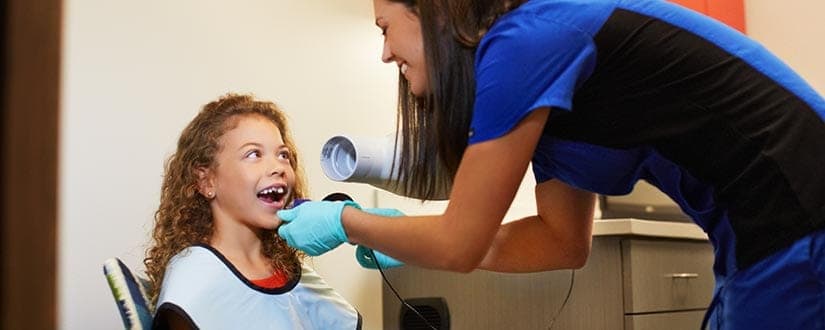A Dental X-ray helps find problems inside the teeth such as tooth decay (especially early stage decay between the teeth), damage to the structure of the mouth, and dental injuries.
The earlier a dental problem is found and treated the better it is for your child.
How Often Does My Child Need a Dental X-Ray?
Doctors Jenkins and LeBlanc follow the guidelines of The American Academy of Pediatric Dentistry which recommends X-rays every 6 to 12 months from the age of two.
Each child is unique and so the number of X-rays will vary based on age, medical/dental history, and the results of the dental exam.
What Kinds of Dental X-Rays Are There?
The three most common types of a dental x-ray are:
Bitewing X-ray
A Bitewing X-ray shows upper and lower teeth in one image from the crown to about the level of the bone that supports the teeth.
They detect decay between teeth and changes caused by bone disease.
Periapical X-ray
A Periapical X-ray shows the entire tooth (in the selected area), from the crown to beyond the end of the root where the tooth attaches in the jaw.
These X-rays can find problems below the gums, including impacted teeth, abscesses, cysts or other problems.
Panoramic X-ray
A Panoramic X-ray captures the entire mouth in a two-dimensional image with a single x-ray.
These X-rays detect positions of un-erupted teeth, abscesses, and other problems. They are also used for planning orthodontic treatment and to evaluate growth and development.
Panoramic or Periapical X-rays monitor the development of wisdom teeth in late adolescence.
Are Dental X-rays Safe?
Dental X-rays are safe but while all X-rays expose the individual to radiation, not all X-ray equipment is equal.
At Jenkins & LeBlanc, we use Digital Radiography, the latest in X-ray technology, which decreases the radiation exposure by 80 – 90% when compared to traditional film X-rays.
In addition, we follow all safety protocols to further minimize exposure including the use of lead aprons and shields.
What is Digital Radiography?
In Digital Radiography, the film replaces a flat electronic pad or sensor.
The X-rays hit the pad the same way they hit the film in older equipment but instead of waiting for the film to develop, the image directly sends to a computer screen.
Along with the benefit of low radiation exposure, this system also allows the image to be stored digitally and quickly accessed to compare with previous images.
Digital images also allow for closer examination. Your child’s dental records become easily transferable in the event of a move or when graduating to adult dentistry.
The ease of transferring records reduces the duplication of X-rays and the expense. Your child and their dental health are important to us! If you have questions, please contact us.
